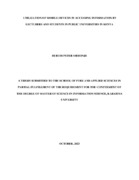| dc.description.abstract | The application of mobile devices is essential in the dissemination of information. In institutions
of higher learning, apart from providing convenience, mobile devices open up new avenues for
academic libraries to enhance access to information. However, more studies need to be carried out
that directly look at the use of mobile devices in enhancing access and use of information. This
study aimed at assessing the utilization of mobile devices in libraries in public universities in
Kenya. The objectives that guided the study were: to identify various mobile devices available in
the libraries; to determine the different ways in which mobile devices are utilized; to examine the
benefits of mobile device utilization; to evaluate the challenges faced in the utilization of mobile
devices, and to determine viable ways of enhancing utilization of mobile devices in public
university libraries in Kenya. The study was guided by the Technology Acceptance Model. The
study adopted the descriptive research design. The study targeted 1620 students, 57 teaching staff
from three academic departments, 91 library staff, and 38 ICT staff from KU and UoN universities.
The study sample size was determined using 10% of the target hence 162 students and six teaching
staff were sampled using stratified random sampling while nine library staff and four ICT staff
were sampled using purposive sampling. Questionnaires and document analysis were used to
collect both primary and secondary data. Descriptive (frequency, percentage, and mean) and
inferential statistics (Chi-Square test and Fisher’s test) were used in analyzing data. The Statistical
Package for Social Sciences (SPSS, ver. 28) was used for data analysis. The study found that the
majority of university students access libraries via mobile devices and that they were mostly used
for accessing e-resources, and online searches for educational materials. The study found a strong
correlation between the use of mobile devices and ease of access to library resources, exposure to
diverse content, convenience of utilization of study materials, and interactive usability of study
materials. The study established the shortage of power outlets for charging mobile devices, lack of
technical assistance, and inadequate internet access were some of the challenges faced in the
utilization of mobile devices in public university libraries. The study concluded that using mobile
devices in university libraries benefits users significantly and relieves pressure on more traditional
library services. The findings of the study will be useful to policymakers and library managers in
improving access to information in libraries. | en_US |
